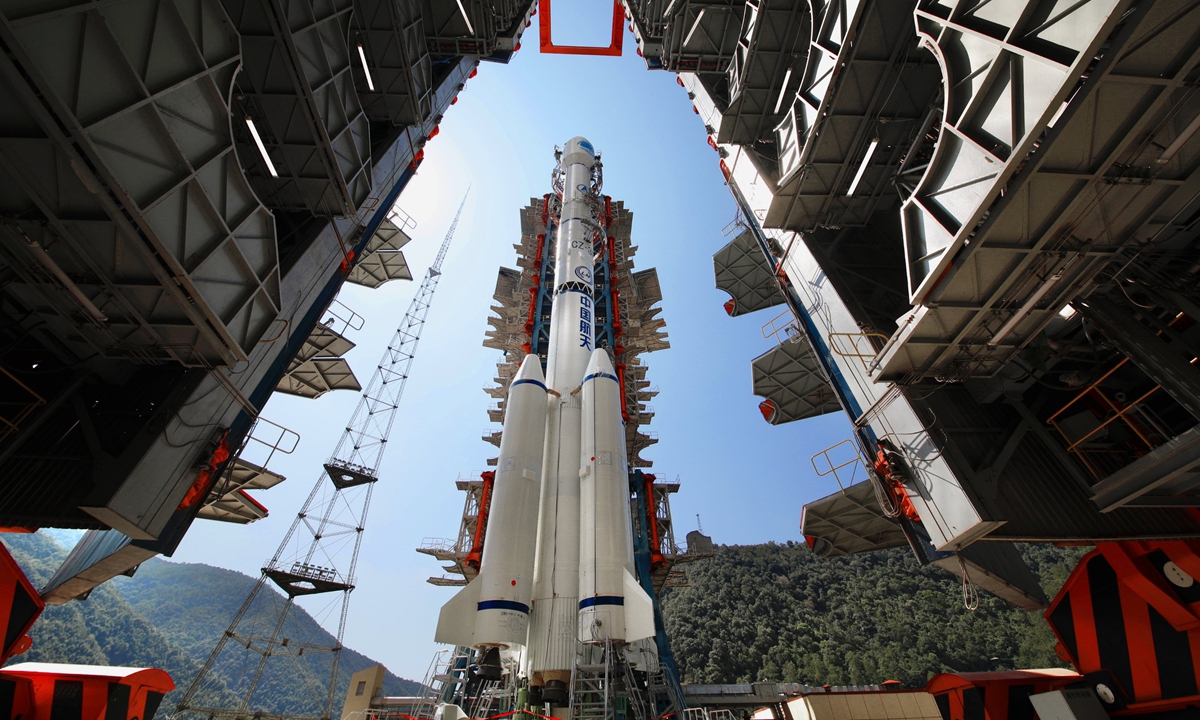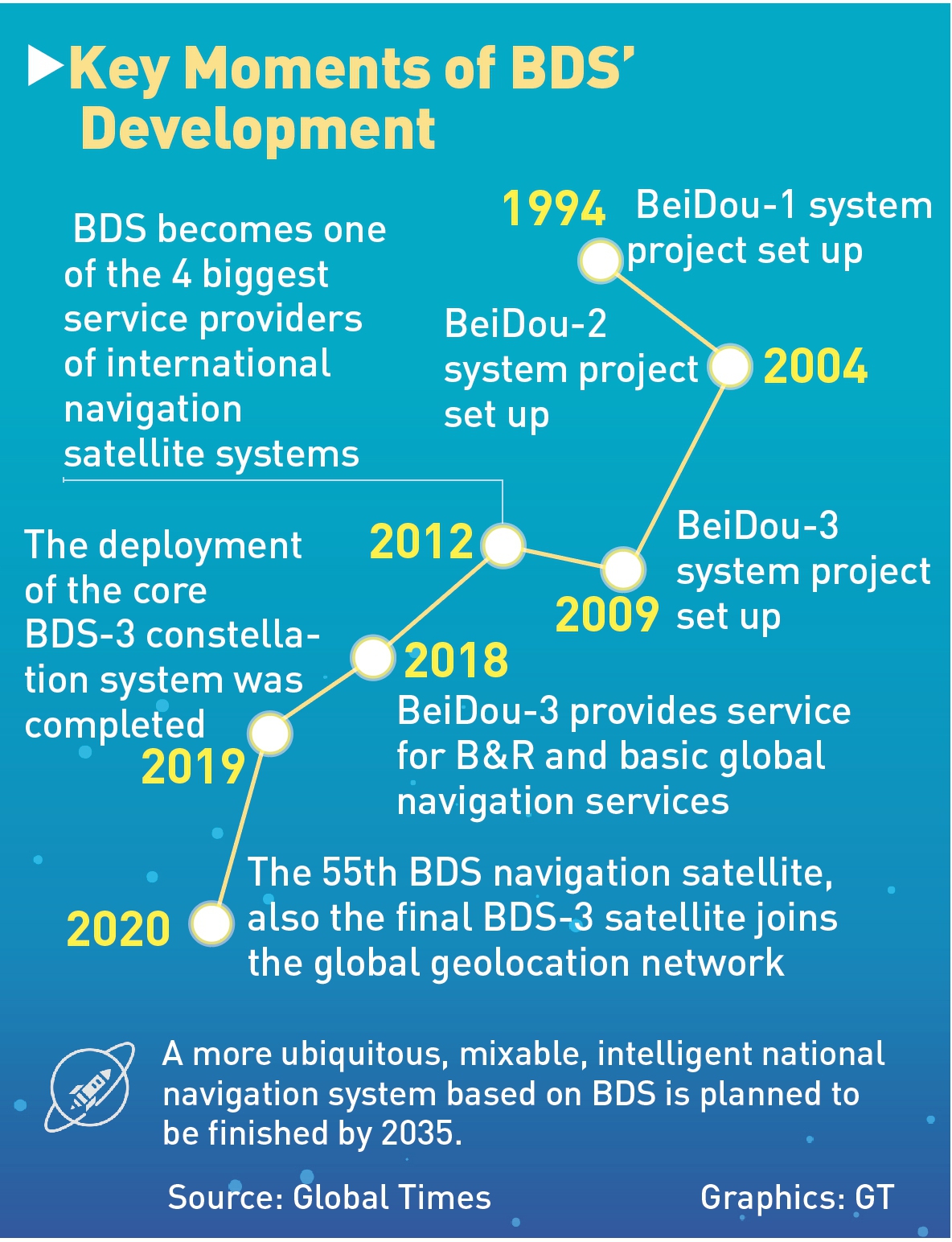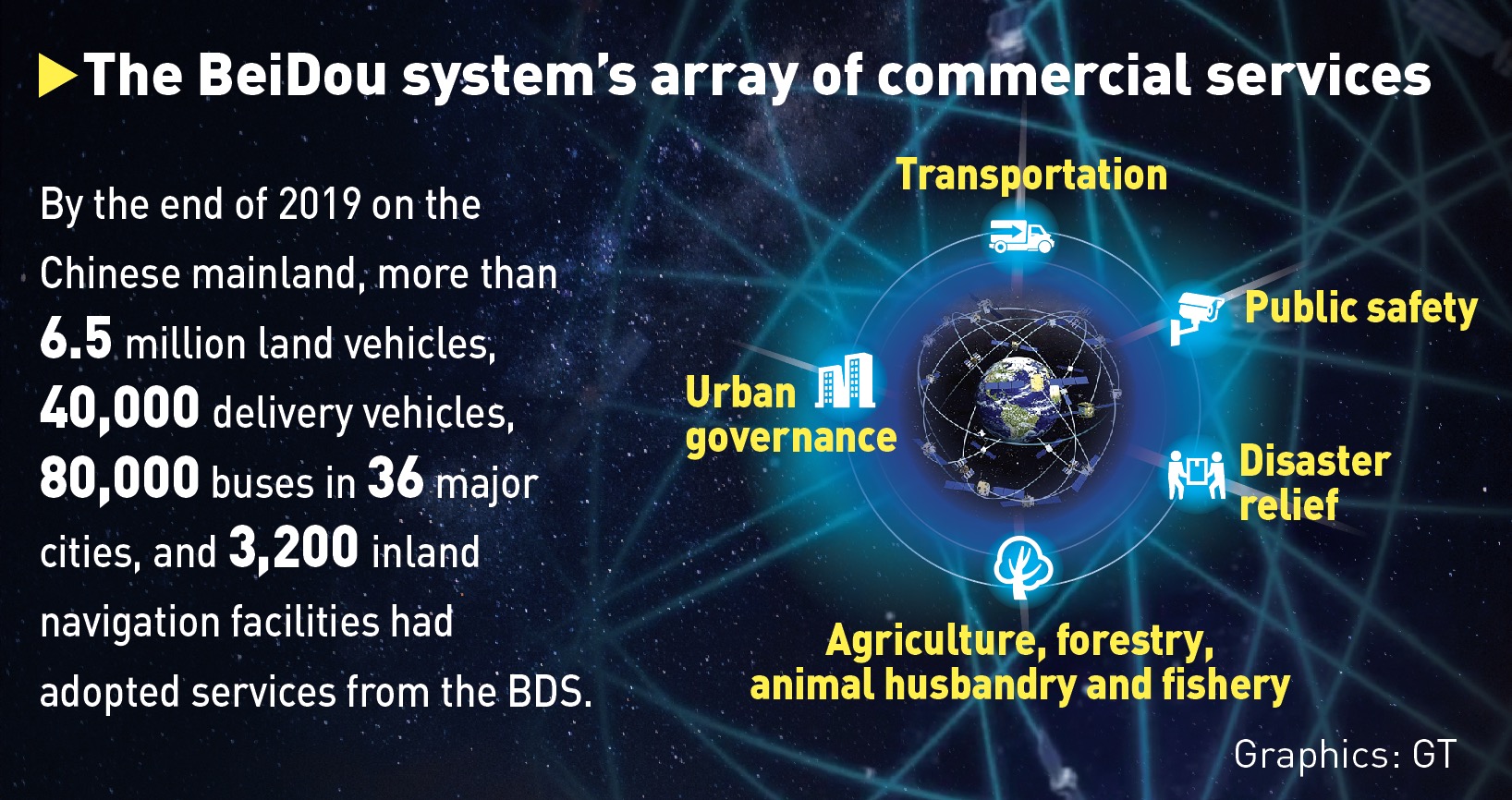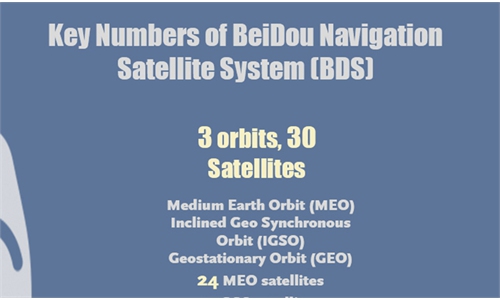
Chinese President Xi Jinping attended a ceremony to mark the launch of full global services of the BeiDou-3 Navigation Satellite System on Friday in Beijing, indicating that China's domestically development and independently operated global satellite navigation system has been fully completed.
The ceremony signals that China is an independent research and development (R&D) country for key innovations as "core technologies cannot be bought or begged for from other countries."
The move also shows that China aims to share the fruits of its technological innovations, compared to the US that has been using its technological edge to bully other countries, experts said.
The BeiDou Navigation Satellite System — or BDS — is China's largest space-based system and one of four global navigation networks, alongside the US' GPS, Russia's GLONASS and the European Union's Galileo.
It provides global users with basic navigation, global short message communication, and international search and rescue services. At present, the system's services have covered more than 200 countries and regions, with more than 100 million users and 200 million daily services.

Graphics:GT
Graphics:GT
"BeiDou is not only China's BeiDou, but also the world's BeiDou. It not only serves China, but also serves the world," Chinese Foreign Ministry spokesperson Wang Wenbin said on Friday.
As a major national technology effort put forward by top decision-makers, the BDS system has been completed in 26 years since it was first started in 1994.
It is a complex space system of the largest scale, with the highest level of service performance, and is closely linked to people's daily lives in terms of transportation, finance, earthquake monitoring, and global search and rescue.
More than 400 entities and over 300,000 scientists worked on the project since its inception. Titans in the science and technology field, like Chen Fangyun and Sun Jiadong, were key in its completion.
"The BDS is the result of efforts by an army of workers mobilized by the Party and nation, and hard work by hundreds of thousands of engineers in all areas, with the firm support of the public," Yang Changfeng, chief designer of BDS project, said.
On June 23, the Long March-3B launch vehicle, carrying the last satellite of the BDS, blasted off from the Xichang Satellite Launch Center in Xichang, Southwest China's Sichuan Province.
The satellite was the 55th member of the BeiDou system, and has begun providing navigation, positioning and timing services.
From November 2017 to June 2020, in 31 months, China successfully launched 30 BeiDou-3 network satellites and 2 BeiDou-2 backup satellites, at a success rate of 100 percent, creating a new record for the world's satellite navigation system network launch, with the speed of deployment exceeding the monthly average of one satellite every month.
Based on independent innovation, the system has completely broken free from relying on imports for its core components and restrictions by others, and all key components are 100 percent home made.
"The ceremony on Friday shows that China is confident in its independent research and development of key scientific and technological innovations, and we are ready to master our own destiny given increasing uncertainty in the external environment," Gao Lingyun, an expert at the Chinese Academy of Social Sciences, told the Global Times on Friday.
Key technologies that cannot be brought or obtained from other countries, especially during this pandemic period, sometimes decide the level of a country's development. The only way for a country to achieve long-term stability and prosperity is to make utmost efforts to ensure their independent development of high technology, Gao added.
China has been fast tracking key exploration projects in recent years.
In January of 2019, China's Chang'e-4 probe touched down on the far side of the moon, becoming the first spacecraft to make a soft-landing on the moon's uncharted side that is never visible from Earth.
Last week, China successfully launched its first Mars probe, named Tianwen-1, via a Long March-5 Y4 carrier rocket from Wenchang Space Launch Center in South China's Hainan Province into planned orbit. The move heralded a new era for China's deep-space exploration that has steadily progressed beyond moon probes to interplanetary missions.
Major projects — including the BeiDou, Moon and Mars missions — and technologies with civilian-military dual usage, should be completed based on independent research and development to avoid being bottlenecked by other countries in key areas, experts said.
"The aerospace industry is an important part of mankind's efforts to explore and use outer space peacefully. It can fully accommodate the joint exploration and cooperation of all countries," Wang from Foreign Ministry said.

Industry chain
The successful launch of the BDS ensures the satellite navigation industry enters "a new golden age" in terms of comprehensive applications, insiders said.
China's domestic satellite navigation and location service sector has grown to accommodate around 14,000 companies with over 500,000 workers in five main industry clusters across the country.
From the core industrial chain, the upstream mainly includes basic components such as chips, card boards, antennas, and electronic maps; the midstream includes system integration, terminal products and software; the downstream mainly focuses on operation services. These fields all have listed companies.
As an independently developed satellite navigation and positioning system, it solves the time and location acquisition that is needed, and will benefit not only military, but also civilian industries in the coming years, Huang Haihui, vice president of the UniStrong Science & Technology Co., told the Global Times on Friday.
China's BDS played an important role in providing mapping services that supported the rapid construction of the Huoshenshan and Leishenshan fang cang temporary hospitals in Wuhan, Central China's Hubei Province, at the beginning of the year when the city was struck by an outbreak of COVID-19.
BDS terminals were also carried to the top of Mount Qomolangma for the first time in late May to help a Chinese surveying team measure the height of the world's tallest mountain.
By the end of 2019 on the Chinese mainland, more than 6.5 million road vehicles, 40,000 postal and express delivery vehicles, 80,000 buses in 36 major cities, 3,200 inland navigation facilities, and 2,900 marine navigation facilities had adopted services from the BDS, forming the world's largest dynamic monitoring system for road vehicles. In the first quarter of 2020, more than 70 percent of smartphones in China used BeiDou services.
A report released by the GNSS and LBS Association of China showed that the industry's market scale is expected to exceed 400 billion yuan by the end of 2020, up from 340 billion yuan in 2019.
Projects that use self-developed technologies also help drive the domestic economic cycle before they extend to overseas markets.
Zhang Quande, secretary-general of the GNSS and LBS Association of China, said the BeiDou global system will provide major services to global users upon its completion, and such services will lay a solid foundation for BeiDou's high-precision ubiquitous applications around the world.

